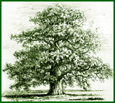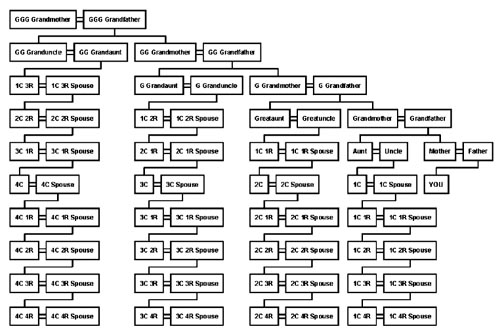Understanding Kinship
by Joelle Steele
 Are you second cousins, half-cousins, third cousins twice removed? Which is which? How do you know?
Are you second cousins, half-cousins, third cousins twice removed? Which is which? How do you know?
It can be confusing when you first try to understand what your relationship is to someone in your very greatly extended family tree. Those who study the genealogy of their families often struggle to figure it out. But, with a little study — and most often with the help of genealogical software — it's not that hard to figure out who you're related to and how to characterize that relationship. The relationships that are most difficult to classify are the cousins.
Degrees and Removals
The degree of a cousin (first, second, third, etc.) is determined by the same relationship that any two people have to a common ancestor. For example, if you both have the same grandparents, you are first cousins (1C), also called "cousins german" or "full cousins," and your cousins are genetically similar to half-siblings. If you share the same great-grandparents, you are second cousins (2C); same great-great grandparents, you are third cousins(3C); same great-great-great grandparents, you are fourth cousins (4C), etc. If you have the same grandmother but different grandfathers, you are half-first cousins (1/2C); same great-grandfather but different great-grandmothers, you are half-second cousins (1/2 2C).
All of these relationships are further modified by their removals, which are the generational relationships you have to a particular descendent or ancestor of your cousin. With descendants, for example, the child of your first cousin is your first cousin once removed (1C1R), sometimes erroneously called your second cousin; the grandchild of your first cousin is your first cousin twice removed (1C2R); a child of your second cousin is your second cousin once removed (2C1R); the grandchild of your third cousin is your third cousin twice removed (3C2R), etc., the degree remaining the same and the removals increasing with each new generation.
With ancestors, the degrees and removals are a little more complicated. For example, the parent of your second cousin is your first cousin once removed (1C1R); the parent of your third cousin is your second cousin once removed (2C1R); the parent of your second cousin once removed is your first cousin twice removed (1C2R); the parent of your fourth cousin is your third cousin once removed (3C1R); the parent of your third cousin once removed is your second cousin twice removed (2C2R), the parent of your second cousin twice removed is your first cousin three times removed (1C3R), etc., with the degrees declining and the removals increasing as you go farther up the tree in ancestors. It's a lot easier to figure out if you have genealogical software or if you simply look at a chart like the ones shown later in this article.
Despite all of these somewhat complicated designations, you are correct in simply calling a cousin a cousin without any further description to designate the way in which they are related to you. But technically, they are genetically different, and as such they are usually defined specifically for the purposes of determining heredity of a disease, suitability for marriage, inheritance of property, etc. In 21st century or modern genealogy, reference is usually made only to the definitions of the various first and second cousins, but there is no limit on the degree to which any two cousins may be related, or to the number of ways in which any two cousins may be related. And, trying to figure out how any two cousins are related, especially as they become more distantly related, is a task best left to a piece of software such as Family Tree Maker, which will print out a kinship report that explains every way in which you are related to everyone else in the family tree.
Multiple Relationships
One of the interesting — but often very confusing — things that happens when you have a family tree with many marriages between cousins is that you become related to people in numerous different ways through the various different lines or branches of the family tree. Most of those relationships are likely to be very distant — 3rd and 4th cousins and beyond. It can be difficult to determine your relationship to your ancestors as well as your living relatives when there is this much marriage between family members going back for generations. I have discovered many distant relatives just by having so many Terjärv born families in my Family Tree Maker software program. It's amazing to know that you are related to thousands of people — many living right in your own back yard.
On my Swedish Finn side of the family, there were two pairs of Terjärv-born cousins who married each other back in the early 18th century. This tied together the ancestry of my grandmother, my grandfather, and my grandmother's first husband (the grandfather of my half-cousins, who are also my full fourth cousins). My grandmother's first husband was a distant cousin of hers and mine. My grandparents were second cousins, making them not only my grandparents but also my second cousins twice removed (2C2R). And, one of my grandmother's sisters, my great aunt, married a cousin who was also my grandfather's uncle. Can this possibly get any more confusing!
As a result of so many intermarriages, I have many multiple relationships with people in my family. For example, my own mother is also my third cousin once removed (3C1R), and she is also my 1/2 5C1R, 5C1R, 6C1R, 7C1R, 8C, 8C1R, 8C2R, 9C, 1/2 11C1R, 1/2 11C2R, 1/2 12C, and 1/2 12C1R. My maternal grandparents are my 2C2R and 6C2R (and a host of other degrees and removals). My brother is also my 4C. My first cousins are also my 4C. And, my half-first cousins are also my full 4C and 6C1R. I am also related to some of my cousins in even greater numbers of degrees and removals, such as my cousin Max who is my 2C, 4C, 6C, 6C1R, 6C2R, 1/2 6C, 1/2 6C1R, 7C, 7C1R, 1/2 7C, 1/2 7C1R, 1/2 7C2R, 8C, 8C1R, 1/2 8C, 1/2 8C1R, 9C, 9C1R, and 10C. And as if that were not enough, I am my own multiple cousin — I am my own 4C, 6C, 1/2 6C, 7C, 8C, 1/2 8C, 8C1R, 9C, 1/2 12C1R, 1/2 12C, and 1/2 13C cousin!
Here are two ways to determine your relationship with another person in your family tree: the Kinship Chart and the Cousin Tree.
KINSHIP CHART

Instructions for Kinship Chart (above)
On the top row, find the relationship of one person to the common ancestor and follow the column straight down. In the left hand column, find the other person's relationship to the common ancestor and follow that row straight across. The relationship is where the selected row and column meet. For example, if you want to know how you are related to someone whose great-grandmother is your great-grandmother's sister, find the common relationship you share with one person, in this case a great-great grandparent (the parent of your great-grandmothers). You are each that one person's great-great-grandchildren (2G GC), making you 3C or third cousins.
- CA = Common Ancestor
- C = Child
- GC = Grand Child
- #G GC = Great Grand Child
- G GC = Number of "greats" (2G GC = Great-great grandchild, 3G GC = Great-great-great grandchild, etc.)
- #C = Degree of Cousin (1C = first cousin, 2C = second cousin, etc.)
- #R = Number of removals (1R = once removed, 2R = twice removed, etc.)
- S = Sibling (brother/sister)
- N = Niece/Nephew
- GN = Great Niece/Nephew (aka Grand Niece/Nephew)
- G GN = Great Great Niece/Nephew (aka Great Grand Niece/Nephew)
- #G GN = Number of "greats" (2G GN = Great-great Great Niece/Nephew)
COUSIN TREE

Instructions for Cousin Tree (above)
Find the box labeled "YOU" and then look at the other relatives in your tree to determine how you are related to each other. For example, if you want to know how you are related to someone whose great-grandmother is your great-grandmother's sister, look at the common relative — the mother or father of your great-grandmothers (i.e., your great-great grandparents). Then look down the chart to the person you are related to who is at the same generation level as YOU and you'll find that you are 3C or third cousins.

